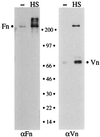Sulfated polysaccharide-directed recruitment of mammalian host proteins: a novel strategy in microbial pathogenesis
- PMID: 10456887
- PMCID: PMC96765
- DOI: 10.1128/IAI.67.9.4463-4468.1999
Sulfated polysaccharide-directed recruitment of mammalian host proteins: a novel strategy in microbial pathogenesis
Abstract
Fundamental to the virulence of microbial pathogens is their capacity for adaptation and survival within variable, and often hostile, environments encountered in the host. We describe a novel, extragenomic mechanism of surface modulation which may amplify the adaptive and pathogenic potential of numerous bacterial species, including Staphylococcus, Yersinia, and pathogenic Neisseria species, as well as Helicobacter pylori and Streptococcus pyogenes. The mechanism involves specific bacterial recruitment of heparin, glycosaminoglycans, or related sulfated polysaccharides, which in turn serve as universal binding sites for a diverse array of mammalian heparin binding proteins, including adhesive glycoproteins (vitronectin and fibronectin), inflammatory (MCP-3, PF-4, and MIP-1alpha) and immunomodulatory (gamma interferon) intermediates, and fibroblast growth factor. This strategy impacts key aspects of microbial pathogenicity as exemplified by increased bacterial invasion of epithelial cells and inhibition of chemokine-induced chemotaxis. Our findings illustrate a previously unrecognized form of parasitism that complements classical virulence strategies encoded within the microbial genome.
Figures





Similar articles
-
Vitronectin binds to the gonococcal adhesin OpaA through a glycosaminoglycan molecular bridge.Biochem J. 1998 Aug 15;334 ( Pt 1)(Pt 1):133-9. doi: 10.1042/bj3340133. Biochem J. 1998. PMID: 9693112 Free PMC article.
-
Vitronectin in bacterial pathogenesis: a host protein used in complement escape and cellular invasion.Mol Microbiol. 2010 Nov;78(3):545-60. doi: 10.1111/j.1365-2958.2010.07373.x. Epub 2010 Sep 27. Mol Microbiol. 2010. PMID: 20807208 Review.
-
[Current concepts on the pathogenicity of phytopathogenic bacteria].C R Acad Sci III. 2001 Oct;324(10):915-22. doi: 10.1016/s0764-4469(01)01375-0. C R Acad Sci III. 2001. PMID: 11570279 Review. French.
-
CCR1 chemokines promote the chemotactic recruitment, RANKL development, and motility of osteoclasts and are induced by inflammatory cytokines in osteoblasts.J Bone Miner Res. 2004 Dec;19(12):2065-77. doi: 10.1359/JBMR.040910. Epub 2004 Sep 20. J Bone Miner Res. 2004. PMID: 15537451
-
Synthesis and characterization of fluorescent and photoactivatable MIP-1alpha ligands and interactions with chemokine receptors CCR1 and CCR5.J Med Chem. 2001 Jan 18;44(2):215-22. doi: 10.1021/jm000982i. J Med Chem. 2001. PMID: 11170631
Cited by
-
Elongation factor Tu is a multifunctional and processed moonlighting protein.Sci Rep. 2017 Sep 11;7(1):11227. doi: 10.1038/s41598-017-10644-z. Sci Rep. 2017. PMID: 28894125 Free PMC article.
-
Mycoplasma bovis mbfN Encodes a Novel LRR Lipoprotein That Undergoes Proteolytic Processing and Binds Host Extracellular Matrix Components.J Bacteriol. 2020 Dec 18;203(2):e00154-20. doi: 10.1128/JB.00154-20. Print 2020 Dec 18. J Bacteriol. 2020. PMID: 33077633 Free PMC article.
-
Mycoplasma fermentans binds to and invades HeLa cells: involvement of plasminogen and urokinase.Infect Immun. 2004 Sep;72(9):5004-11. doi: 10.1128/IAI.72.9.5004-5011.2004. Infect Immun. 2004. PMID: 15321992 Free PMC article.
-
Streptococcal erythrogenic toxin B abrogates fibronectin-dependent internalization of Streptococcus pyogenes by cultured mammalian cells.Infect Immun. 2000 Jun;68(6):3226-32. doi: 10.1128/IAI.68.6.3226-3232.2000. Infect Immun. 2000. PMID: 10816467 Free PMC article.
-
Identification of a novel streptococcal adhesin P (SadP) protein recognizing galactosyl-α1-4-galactose-containing glycoconjugates: convergent evolution of bacterial pathogens to binding of the same host receptor.J Biol Chem. 2011 Nov 11;286(45):38854-64. doi: 10.1074/jbc.M111.260992. Epub 2011 Sep 9. J Biol Chem. 2011. PMID: 21908601 Free PMC article.
References
-
- Baggiolini M, Dewald B, Moser B. Interleukin-8 and related chemotactic cytokines—CXC and CC chemokines. Adv Immunol. 1994;55:97–179. - PubMed
-
- Barnes D W, Reing J E, Amos B. Heparin-binding properties of human serum spreading factor. J Biol Chem. 1985;260:9117–9122. - PubMed
-
- Ben-Baruch A, Xu L, Young P, Bengali K, Oppenheim J, Wang J. Monocyte chemotactic protein-3 (MCP3) interacts with multiple leukocyte receptors. C-C CKR1, a receptor for macrophage inflammatory protein-1 alpha/Rantes, is also a functional receptor for MCP3. J Biol Chem. 1995;270:22123–22128. - PubMed
-
- Bodaghi B, Jones T R, Zipeto D, Vita C, Sun L, Laurent L, Arenzana-Seisdedos F, Virelizier J L, Michelson S. Chemokine sequestration by viral chemoreceptors as a novel viral escape strategy: withdrawal of chemokines from the environment of cytomegalovirus-infected cells. J Exp Med. 1998;188:855–866. - PMC - PubMed
-
- Cardin A D, Demeter D A, Weintraub H J, Jackson R L. Molecular design and modeling of protein-heparin interactions. Methods Enzymol. 1991;203:556–583. - PubMed
MeSH terms
Substances
LinkOut - more resources
Full Text Sources
Other Literature Sources
Miscellaneous

